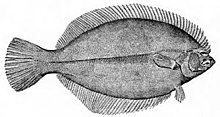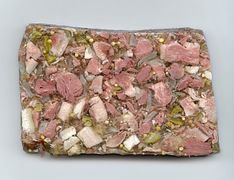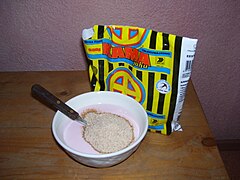Estonian cuisine
| Part of a series on the |
| Culture of Estonia |
|---|
 |
|
People |
| Languages |
| Cuisine |
| Festivals |
| Religion |
| Sport |
Traditional Estonian cuisine has substantially been based on
Cold table

The first course in traditional Estonian cuisine is based on cold dishes—a selection of pickles, meats and

In the 20th century, a special sandwich called kiluvõileib has become popular. This sandwich consists of a traditional rye bread open sandwich with thin layer of butter and a layer of vürtsikilu (pickled Baltic sprats) as topping. Boiled egg slices, mayonnaise and culinary herbs are optional extra toppings.[citation needed]
Soups
Main course

Black rye bread (rukkileib) accompanies almost every savory food in Estonia. Estonians continue to value their varieties of black rye-based bread.[citation needed]
Desserts

Specific desserts include kissell, kohuke (curd snack) and kama. Other common Estonian desserts are mannavaht (a cream made of semolina and juice or fruit), kohupiimakreem (creamy curd), kompott (compote) and martsipan (marzipan). Rhubarb pies are also a favorite. Another popular dessert is kringel (kringle), a sweet yeast bread often flavored with cardamom. Pancakes (pannkook, plural pannkoogid) are also traditional, common, and popular. They are fried and are usually with sweet fillings but they can be savoury too. Vastlakukkel, a cardamom-spiced bread roll with whipped cream is a traditional Estonian sweet roll, especially popular during the festivies of vastlapäev.[3]
During Soviet times, Estonians invented several easy-to-make desserts that are most commonly eaten during birthdays, especially children's birthdays. Few such examples are kirju koer (cacao and butter that gets mixed with crumbled cookies and marmalade and then put into the freezer for a night), kass Artur (soft toffee and butter that gets mixed with corn sticks and then put into the freezer for a night) and küpsisetort (layered cake that is made with square-shaped cookies of Kalev, kohupiimakreem and jam and then put into the freezer for a night).
Drinks

The traditionally popular drink kali, similar to
Milk (piim) is also widely drunk by children as well as adults. Other dairy products besides milk include keefir and also hapupiim ("sour milk") and pett, which are variations on the theme of buttermilk. Dairy from Andre, Estonia is well known as part of Estonian dairy-related cuisine.[5]
Seasons
Summer and spring
Traditionally in summer and spring, Estonians like to eat everything fresh—berries, herbs, vegetables and everything else that comes straight from the garden. Hunting and fishing were common in history. Nowadays, they have remained as popular pastimes. It is popular to barbecue in the summer.[citation needed]
Winter and Christmas
During the winter months,
Gallery
-
Oven-cooked verivorst (blood sausage)
-
Sült (head cheese)
-
Mulgipuder, a national dish of Estonia made with potatoes, groats, and meat
-
Hernetatrapuder, a pea and buckwheat porridge
-
Sepik (whole wheat bread)
-
Kama, a finely milled cereal and legume flour generally eaten mixed with milk, buttermilk, yogurt, or kefir, or used for making desserts
Notes and references
- ^ Eesti Toit infoserver v2.0.3.0 Archived December 17, 2007, at the Wayback Machine
- ^ a b Estonia By Michael Spilling
- ^ Rosa, Natalia (27 February 2020). "A first timer's guide to wholesome and delicious Estonian Food". Trafalgar.com. Retrieved 13 May 2023.
- ^ "Alcohol market, consumption and harms in Estonia Yearbook 2022".
- ^ "The cheeses from Andre Farm are the first in Estonia to get international top quality stars".






